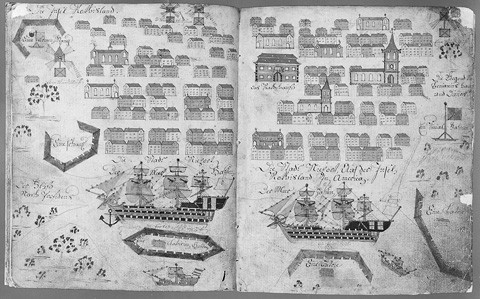
Georg Daniel Flohr, View of Newport, ca. 1780–1781. Ink and watercolor on paper. (Courtesy, Bibliotheque Municipale, Strasbourg, France.)
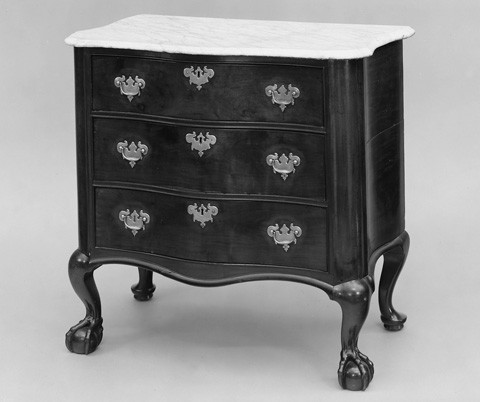
Commode attributed to John Goddard, Newport, Rhode Island, 1760–1775. Mahogany with chestnut and white pine; marble. H. 34 3/4", W. 36 3/4", D. 21 1/2". (Courtesy, Metropolitan Museum of Art.)
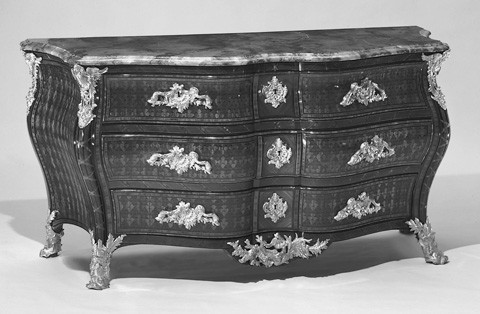
Commode, probably Paris, France, ca. 1735. Oak. Dimensions not recorded. (Courtesy, Museum of Fine Arts, Boston, bequest of Susan Greene Dexter in memory of Charles and Martha Babcock Amony.
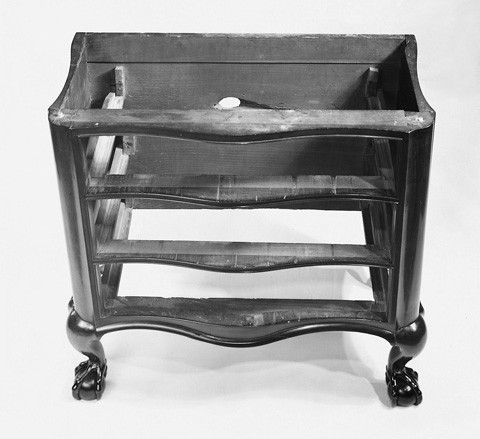
Carcass of the commode illustrated in fig. 2. (Courtesy, Sack Heritage Group) www.sackheritagegroup.com

Underside of the commode illustrated in fig. 2. (Courtesy, Sack heritage Group) www.sackheritagegroup.com
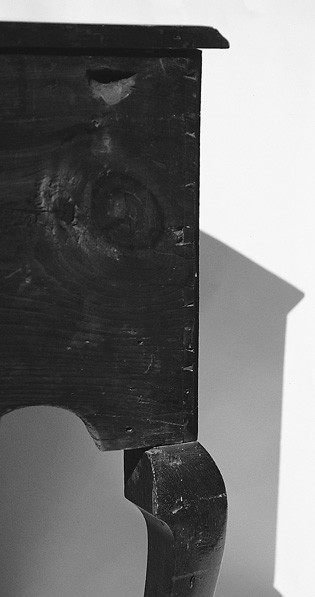
Detail of the back of a dressing table made by Job Townsend, Jr., for Samuel Ward, Sr., Newport, Rhode Island, 1746. (Courtesy, Chipstone Foundation; photo, Jonathan Prown.)
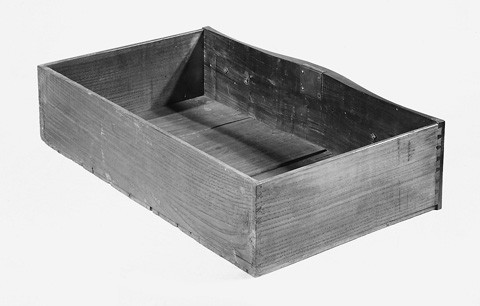
Drawer of the commode illustrated in fig. 2. (Courtesy, Sack Heritage Group) www.sackheritagegroup.com
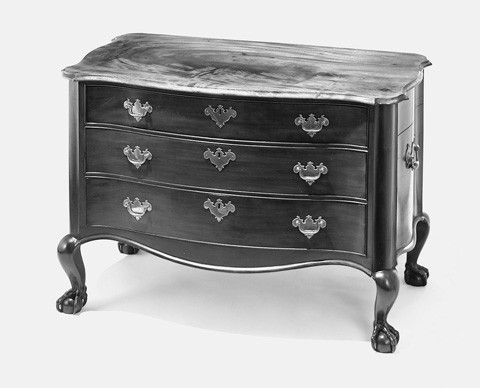
Commode attributed to John Goddard, Newport, Rhode Island, 1765–1775. Mahogany with red cedar, chestnut, and pine. H. 35 1/4", W. 51 1/2", D. 27 1/4". (Courtesy, Museum of Fine Arts, Boston, gift of Mary Bowen Polk in memory of her parents, Mr. and Mrs. Edward Calliper Bowen.)

Commode, Montreal, Quebec, Canada, 1780–1790. Butternut and white pine. H. 34 1/4", W. 47 1/4", D. 24 3/4". (Courtesy, Museum of Fine Arts, Boston, gift of Mrs. Dorothy Buhler in memory of Sarah M. Gilbert, gift of Estelle S. Frankfurter, and gift of John Gardner Green Estate, by exchange.)
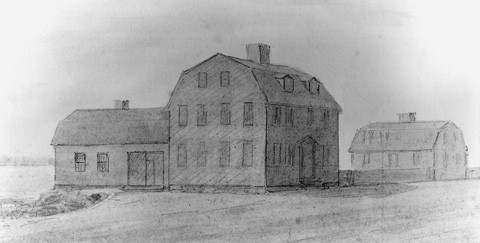
Jonas Bergner, drawing of John Goddard’s house and shop, Newport, Rhode Island, before 1870. Watercolor on paper. (Courtesy, Newport Historical Society.) The house and shop were built before 1758.

Tea table made by John Goddard, Newport, Rhode Island, 1763. Mahogany with tulip poplar. H. 26 7/8", W. 32 3/4", D. 20 3/8". (Courtesy, Winterthur Museum.)
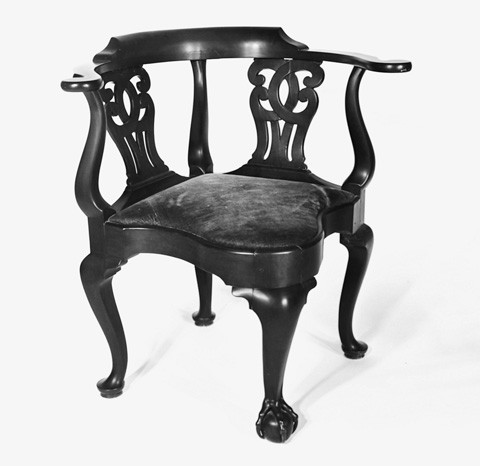
Roundabout chair attributed to John Goddard, Newport, Rhode Island, 1760–1775. Mahogany with maple and white pine. H. 31", W. 25 1/2", D. 17 1/2". (Courtesy, Shelburne Museum.)
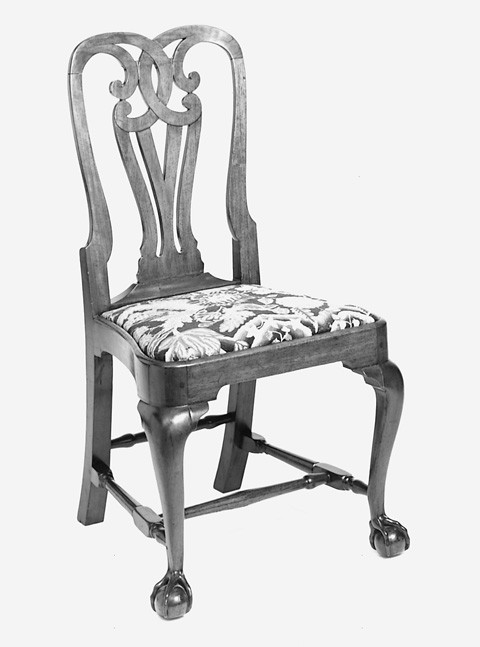
Side chair, Newport, Rhode Island, 1791–1792. Sabicu and maple. H. 37 3/4", W. 20 1/8", D. 20 1/8". (Courtesy, Winterthur Museum.) The chair is one of a pair that descended in the Almy-Ellery-Bangs families of Newport.
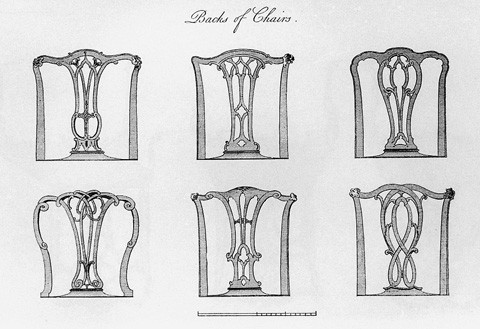
“Backs of Chairs” illustrated on pl. 16 in the third edition of Thomas Chippendale’s Gentleman and Cabinet-Maker’s Director (1762). (Courtesy, Historic Deerfield, Inc.; photo, Penny Leveritt.)
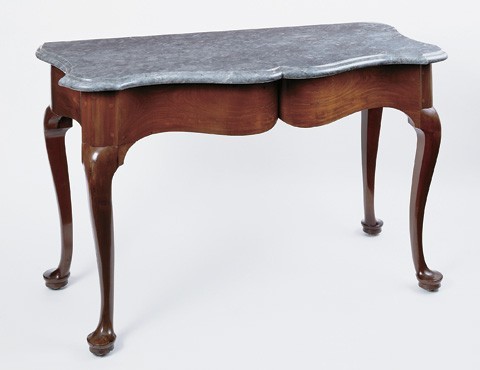
Sideboard table made by John Goddard, Newport, Rhode Island, 1755. Mahogany with maple and chestnut; marble. H. 26 3/4", W. 45 1/2 ", D. 21 7/8". (Private collection; photo, Gavin Ashworth.)
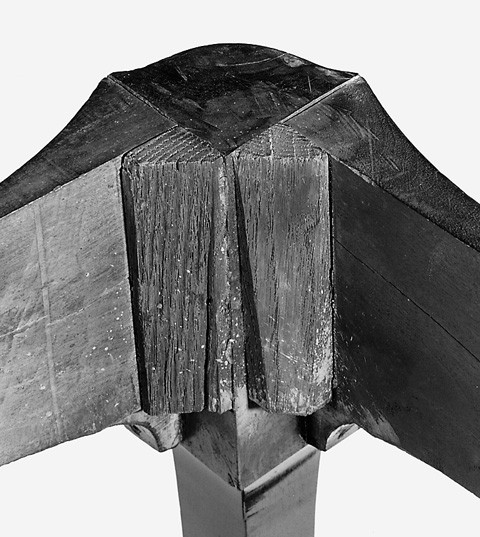
Detail of a front leg of the side-
board table illustrated in fig. 15. (Photo, Gavin Ashworth.)

Sideboard table attributed to John Goddard, Newport, Rhode Island, 1755–1770. Mahogany with maple; marble. H. 29", W. 45", D. 21 3/4". (Courtesy, The Preservation Society of Newport County; photo, Gavin Ashworth.)
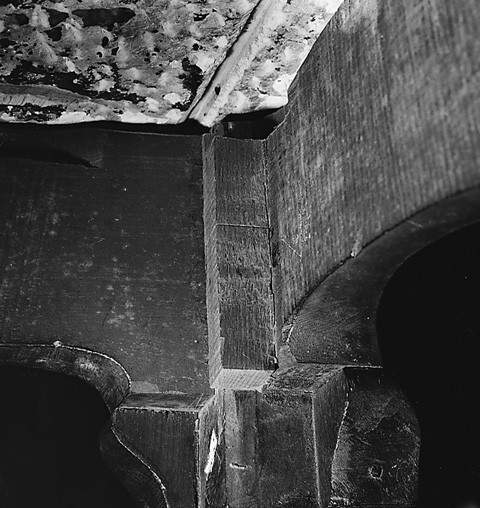
Detail of the right front leg of the sideboard table illustrated in fig. 17. (Photo, Gavin Ashworth.)
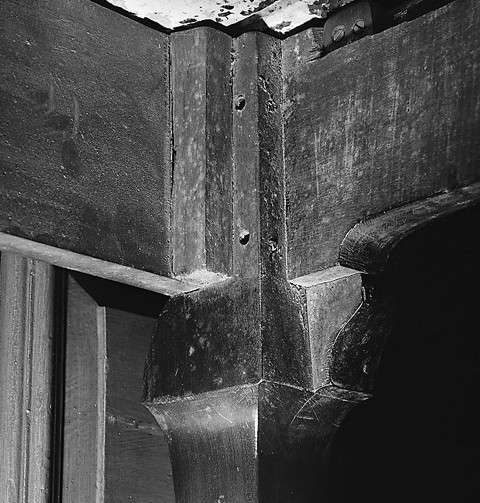
Detail of the right rear leg of the sideboard table illustrated in fig. 17. (Photo, Gavin Ashworth.)

Sideboard table, Newport, Rhode Island, 1755–1775. Mahogany with maple; marble (replaced). H. 27 1/4", W. 31 1/2", D. 18 1/2". (Private collection; photo, Gavin Ashworth.)
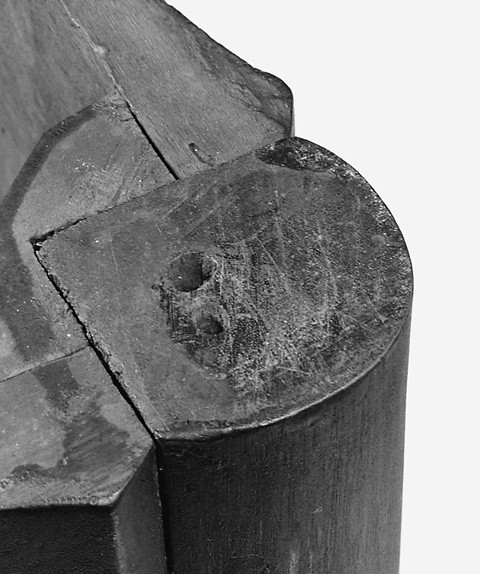
Detail of the right front leg of the sideboard table illustrated in fig. 20. (Photo, Gavin Ashworth.)
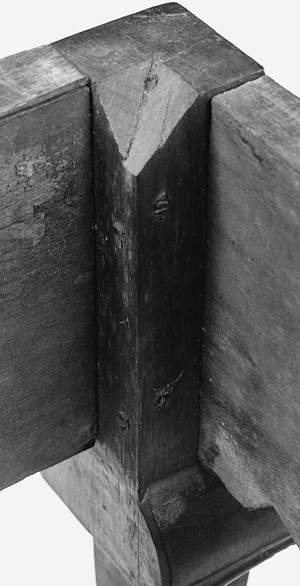
Detail of the right rear leg of the sideboard table illustrated in fig. 20. (Photo, Gavin Ashworth.)
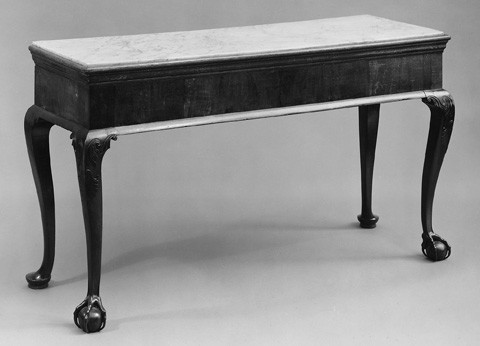
Sideboard table attributed to the shop of John Goddard, Newport, Rhode Island, 1760–1775. Mahogany and mahogany veneer with maple and white pine; marble. H. 28", W. 50", D. 17". (Courtesy, The Metropolitan Museum of Art, Bequest of Vincent D. Andrus, 1962 (62.138a,b) Photograph © Te Metropolitan Museum of Art.)
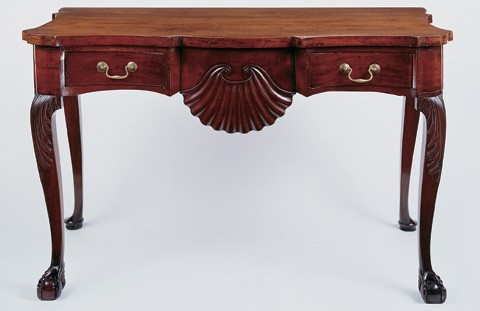
Side table attributed to John Goddard and Job Townsend, Jr., Newport, Rhode Island, 1750–1765. Mahogany with red cedar. H. 30", W. 50", D. 25". (Courtesy, Redwood Library and Newport Preservation Society; photo, Gavin Ashworth.)
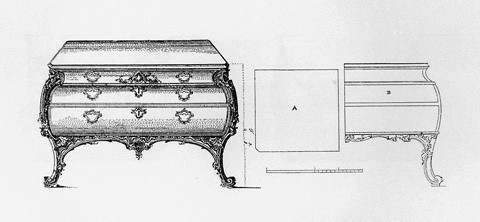
“French Commode Table” illustrated on pl. 64 in the third edition of Thomas Chippendale’s Gentleman and Cabinet-Maker’s Director (1762). (Courtesy, Historic Deerfield, Inc.; photo, Penny Leveritt.)

J. P. Newell, detail of “NEWPORT, R.I. IN 1730,” Boston, 1864. Lithograph. 18" x 28". (Courtesy, Historic Deerfield, Inc.; photo, Penny Leveritt.) This lithograph, printed by J. H. Bufford, is after an overmantle painting from the Phillips House on Mill Street. The painting is owned by the Newport Art Museum. The date in Newell’s title is incorrect. The overmantle painting is dated 1740 based on the construction of the Colony House in 1739 and the extension of Long Wharf in 1741.

Fireplace surround installed in Godfrey Malbone, Jr.’s, house by John Stevens, Jr., Newport, Rhode Island, 1749. Marble. H. 49 1/2", W. 68", D. 6 3/4". (Courtesy, Newport Historical Society; photo Gavin Ashworth.)
When cultures merge or collide, misunderstanding and change are inevitable, especially at the very edges of cultural preference where anomalies create confusion. Even when social contact is temporary, culture evolves by altering its values to absorb what it likes. Consequently, when the French fleet under the command of Admiral Charles Louis d’Arsac, chevalier de Ternay (1722–1780), sailed into Narragansett Bay with Comte de Rochambeau’s army on July 10, 1780, Newporters were wary even though the foreigners were allies of the Continental cause and preferable to the British, who had occupied the city between 1776 and 1779 and had destroyed its colonial wealth. The wartime occupations of Newport, and indeed the city's entire colonial history, produced a blend of cultures that rarely stood still for analysis. When de Ternay’s fleet arrived, Newporters already knew more about French culture than did most Americans. After all, they had been trading with the French for most of the eighteenth century, despite—or because of—numerous Parliamentary trade restrictions.
Among the French soldiers and sailors who went ashore was a German mercenary named Georg Daniel Flohr (1756–1826) of the Regiment Royal Deux-Ponts. In his journal, Flohr describes cultural confusion, which in retrospect was only the contemporary wave of adaptation and change that swelled into Newport harbor, a place accustomed to welcoming people from around the maritime world since the seventeenth century. Flohr saw Newport through different cultural eyes. His drawing of the city reveals his Rhenish origins and reminds us that there was no cultural purity in America’s colonial seaports (fig. 1). Just by going ashore, Flohr himself stirred more ingredients into the soup. He wrote (in German):
We cast anchor and the city of Newport now lay before our eyes. It is adorned with a very beautiful Town Hall [the Colony House] as well as a beautiful church tower. As soon as we had cast our anchors, sloops from the town approached our ships in order to sell us their wares such as cherries, apples, pears, &c. The people in these sloops were all black, that is, moors. We however could not talk a word with them and neither could they talk to us, because their language was English. . . . [Later, on July 14th] we started to disembark . . . to meet the people who lived there. But as soon as we entered the city we could not see anybody but some blacks . . . which made us believe that the whole city was inhabited by blacks. But that was not so: the white inhabitants had just all gone into hiding. . . . As soon as they saw . . . that we were their friends . . . they slowly returned to the city.[1]
Flohr was wrong to think that Newport was peopled entirely by Moors, as he put it, but his cultural analysis on his first day in Rhode Island still struck at the root of why the city had prospered before the Revolution and was different from many colonial ports. He was puzzled by the apparent uniformity of the population in a bustling seaport where maritime trade had forged a hybrid of tastes and beliefs on every noisy street corner for two generations prior to the Revolution. In truth, Newport revealed itself to be a microcosm of the entire Atlantic basin, where a polyglot of wealthy people, dominant tradesmen, and competing “want-to-bes” defined themselves by where they came from and where they wanted to go.
Although Flohr initially misinterpreted the evidence, it was the anomaly of race that attracted his attention, not Newport’s longstanding traditions, like religious tolerance, or its acknowledged emblems in the built environment, like rum distilleries or block-and-shell furniture. Later, another apparent anomaly offered a defining moment. Good deeds always change attitudes, and certainly public opinion of the French was boosted when “Two soldiers of the Royal Deuce Points regiment having found in one of the streets of Newport, a Silver Spoon, and brought it to their Captain. . . . Whoever has lost the same, may have it again, by applying to the said Baron de Whisk, and proving their property.” Honor replaced uncertainty and quickened the pace of acculturation.[2]
This article addresses cultural differences in an urban setting and the attraction of appearing both different and knowledgeable in an environment where change is the most fashionable thing of all. Consequently, this essay is less about mainstream consumerism shaped by homogeneity and its handmaidens: technical efficiency and accelerated repetition. Our probe to the core of excessive consumerism in Newport focuses on a handful of exceptional serpentine commodes, sideboard tables, and corner chairs that appear more Franco- than Anglo-American. True, this serpentine furniture is only a footnote to the be-shelled monuments of Newport cabinetmaking built by the Townsends and Goddards, and certainly it is isolated from the central story of Newport craftsmanship: the well-constructed, stripped-down desks and tables made for export to the southern colonies and the West Indies. Since most of this serpentine furniture was made by John Goddard (1724–1785), however, it deserves study and, as an anomaly, may say as much about what Newport was really like during Rhode Island’s “golden age” as any other part of its surviving material culture.[3]
For three-quarters of the eighteenth century, most Newporters must have thought that the whole world was their oyster. Religious tolerance and a total commitment to maritime trade brought prosperity and broad cultural exposure to most of them. The wealthy enjoyed the finest material goods and had the knowledge to use them well. Their business connections lay on four continents; they traveled for pleasure and educated their children abroad; and many of them or their parents had come to Newport from Great Britain, France, Portugal, the West Indies, and Boston.
To a stranger, early Newport must have seemed like a social experiment gone haywire. On an island, surrounded by smaller islands and an unproductive hinterland, Newporters readily turned to the sea for their livelihoods and necessities. In the seventeenth century, the place became a safe haven for heretics, from the perspective of John Winthrop’s corporate theocracy. The hoped-for purity of the Massachusetts Bay Colony was achieved partly by making Rhode Island a theological dumping ground; therefore, the vitality that comes with heterogeneity was planted early in the Providence Plantations through the settlement of Quakers, Baptists, Jews, Antinomians, Moravians, Anglicans, Catholics, Congregationalists, Huguenots, and Africans, among others. Although there was tension, this rich mixture of creeds was bound by an island mentality and by that great leveler in the quasi-democratic setting of religious and cultural toleration—profit.[4]
Newport flourished under the benign neglect of the Boston government and London. As early as 1739, Newport merchants engaged in direct trade with England, desiring to “make themselves Independent of the [Massachusetts] Bay Government to whom they have mortal aversion.” Most notably, Newporters participated in the so-called triangular trade, which was ultimately polygonal. Rhode Island ships carried rum to West Africa where it was ignominiously traded for slaves, who were sold in the West Indies for molasses, which in turn was sent northward on the Gulf Stream to Newport to be distilled into rum for Africa. By 1761, Newport alone supported sixteen distilleries, according to Yale’s future president and observant minister of the Second Congregational Church, the Reverend Ezra Stiles (1727–1795). Merchant Godfrey Malbone, Jr. (1724–1785), described how the triangular trade worked in a 1764 letter to his London creditors: “In Respect to the debt . . . we propose to discharge it, by [making the] . . . next Importation of Molasses into a Cargo of Rum, which we shall Send to the Coast of Guinea for the Purchase of slaves, which We shall order to the W. Indies, to be There Sold for Bills of Exchange and remitted to you.”[5]
Between 1730 and 1775, Newport merchants continually sought ports-of-call to purchase new cargoes with the profits of the one just sold. The coastal and Atlantic trades were both lucrative, and a Newport captain might steer his vessel on a zigzag course driven as much by supply and demand as by the prevailing winds. Newporters knew exactly which commodities were available in each colony and port on a seasonal basis, including Charleston, South Carolina (rice, indigo), eastern North Carolina (tar), Norfolk, Virginia (tobacco), Newfoundland (dried fish), Nantucket (whale oil), Connecticut (livestock), and New Jersey (shingles). Most enticing were manufactured goods from London, but Newporters were always eager to deal with the sugar planters in the French West Indies (despite Parliament’s trade restrictions) because they produced molasses more cheaply than did their English counterparts. Martinique, Antigua, and Guadeloupe, as well as Dutch Surinam, were regular haunts of the Newport maritime community. In this rapidly growing economy, Newport cabinetmakers also found markets for furniture in the Caribbean and the American South, and Rhode Island iron founders became the largest exporters of cast-iron goods in America. On the Gulf Stream each summer came the most extravagant imports of all: the very families of Newport’s wealthy trading partners in the West Indies and the South, who summered in breezy Newport after the 1720s and brought their tastes and expectations with them.[6]
The free trade of molasses, rum, and slaves created fortunes that were made, lost, and made again with skill and luck on the high seas. Since the fecundity of the immediate mainland was limited to fine Narragansett horses supplemented by cattle and cheese for export, Newport merchants made their livings like many of today’s truckers with their eighteen-wheelers. They assembled other merchants’ cargoes and carried them for profit. Although more risky, such deals forged rapidly changing conglomerates that rarely depended on the vicissitudes of a single, local market. When conditions turned sour, luck was as important as skill, and the merchant and his captains had to keep in touch through correspondence handed from ship to ship. A captain’s resourcefulness had far more influence upon the success of a voyage than did the merchant, no matter how rich, thousands of miles away in his counting house. In 1750, Captain Richard Chilcott wrote to his brother-in-law, Godfrey Malbone, Jr., “Merchant in Rhod [sic] Island,” from Montseratte via St. Kitts. Chilcott began by reporting that he had just sold one-eighth of the ship’s cargo to an Irishman named Kennedy Mulkere but went on to ask Malbone to insure it at £125 sterling as part of their business deal. He added:
[The ship] is to Touch at St. Eustata, Coroso & Jamaca . . . and we shall put 40 hhds [hogheads] of Rum on Board. . . . The [other] sloop is to Return Directly with Lumber & horses. . . . I have sold all my Cargo (Except my hoops) . . . and my horses for 40 £ sterling each. . . . [But] Never was known such times in the West Indies before, wee have not had any Rain Since last March. . . . Gentlemen who Expected to make 1000 hhds of Sugar think themselves well of to make 50. I am allmost Ruin’d . . . [and] I have lost . . . 13 Negros and above 200 [pounds sterling] in Cattle and Mules. . . . I am almost mad. . . . I have sent you a small Turtle . . . I’ll send you a Larger One if I can get one. I would have you some Lemons, but I [forgot][7]
With Newport’s reliance on overseas trade, any threatened trade restriction or tax was an anathema to a Rhode Islander. Faced with rumors of the impending Sugar Act, Stephen Hopkins (1707–1785) catalogued Newport shipping in 1763. At that time, local merchants owned 352 vessels engaged in the Atlantic coastal trade, 183 ships that plied the seas to Europe and the West Indies, and 18 vessels that followed routes to and from Africa. Although the records are incomplete, Newport had sent more vessels to Africa than to any other colonial port by 1770, and its merchants played a role in selling 40,000 Africans into slavery between 1760 and 1775. Consequently, Newport was the only colonial port with a favorable balance of trade in the West Indies during the late 1760s, and its streets were literally paved with the profits of slavery. As early as 1715, the General Assembly voted that one-half of the revenue derived from the slave trade for seven years would be used to pave the streets “from Ferry House to the Colony House.” After Charleston, Newport had the highest ratio of African-Americans in the total population of any colonial American city. Nearly 30 percent of Newport families owned 1084 slaves in a local population of 9209 in 1774. These slaves were the individuals who watched with their own skepticism when Georg Daniel Flohr came ashore in July of 1780.[8]
Although their morals can be questioned today, Newport merchants valued wealth more than personal salvation when taking cash profits on the sales of slaves and rum. Their credit in the worldwide economy became enormous, and the overall well-being of most Newporters improved during this economic flood. All the leading families owned and traded in slaves and rum: the Jews Aaron Lopez (1731–1782) and Jacob Rodriques Rivera (1717–1789); the Anglican Malbones, Wickhams, Wantons, Vernons, and Stoddards; and Quaker Abraham Redwood, Jr. (1709–1788). Almost everyone was a merchant or aspired to become one. Silversmith Jonathan Otis (1723–1791), for example, owned interest in a slave ship, and he and Quaker cabinetmaker John Townsend (1733–1809) owned slave.[9]
The wealthy households in this pan-cultural society were only a dream for most tradesmen in colonial America, but in early Newport, craftsmen of all sorts supplemented the imports from the world market with their own products. Cabinetmakers, for example, made thousands of pieces of furniture as venture cargo in the coastal trade. Newport’s pulsing economy supported an abnormally large number of furniture makers relative to the size of the population (one man in a hundred) and encouraged the mastery of skills through specialization. A captive audience of well-to-do consumers, with their personal identities and stated aspirations, took their most demanding commissions to these tradesmen’s shops. The Townsends, the Goddards, Benjamin Baker (fl. 1751–1792), John Cahoone (ca. 1725–1792), and others—simultaneously collaborators and competitors depending on the day of the week—vied to make costly block-and-shell furniture and other status symbols for the town’s merchant-princes, even as they departed this world. In 1764, Job Townsend, Jr. (1726–1778), charged the estate of Bernard Senior, Esq., £100 for “a Black walnut Coffin Lined with whit[e] Swan Skins & Covered with Black Broad Cloath Eight Doz of Clasps & 3 par of handles.”[10]
This was the cosmopolitan setting in which Newport’s serpentine furniture was made. The egocentric attitude of both patron and craftsman drove the creation of the form, just as it did the “standard” block-and-shell furniture. If the town’s cabinetmakers could make beautifully designed, constructed, and carved furniture from the finest materials available in the maritime trade, they could certainly develop the templates to make a French-style, marble-top serpentine commode if a client requested one. But who were the patrons for these forms, and what kind of people were they? Who were the artisans who made them? When was this furniture actually built? And where did the ideas, materials, and skills come from? These questions surround Newport’s serpentine furniture and, as an anomaly, demonstrate its significance in defining the culture and economy of the city.
Three serpentine commodes survive, although one was stolen in the 1970s and its location remains unknown. The commode illustrated in figure. 2 has a typed label recording its descent from Robert (ca. 1717–1802) and Ann Wickham Crooke of Newport, who were married in 1747. Fitted with a white and gray-veined, serpentine marble top with a molded edge, its frame is a symphony of serpentine and cyma curves that makes the object appear larger than its dimensions. Undulating shapes define each profile and angle of the commode, which speaks “Rhode Island” with a distinct French accent and appears inspired by the Louis XV style (fig. 3). Only the tall, distinctively carved claw feet at the front, turned pad feet at the rear, and imported English hardware reveal the ruse, at least until the commode is disassembled to expose its construction.[11]
The carcass is assembled with mortise-and-tenon joints similar to those used by Continental tradesmen; consequently, the chest lacks the dovetailed top and bottom boards common in Anglo-American case construction. The cabriole front legs with rounded corners, which are serpentine themselves, are solid posts that define the height of the object. They receive the floating tenons of the drawer dividers in blind mortises bound by the mortised and pinned lower rail—right through the knees of the cabriole legs—and the dovetailed top rail (fig. 4). The rails are chestnut faced with mahogany, and the bottom rail is a composite of mahogany boards laminated to achieve the thickness of the serpentine shape. The drawer supports are rabbeted into the front drawer dividers and mortised into the backboards.
The shaped sides of the case are composed of three horizontal boards mortised into the front posts with four visible pins. The bottom board is thicker and functions like a rail. Instead of a joined or paneled back, the carcass is fitted with a two-board dovetailed back, the narrower chestnut board forming a thin rail at the top (fig. 5). Surprisingly, there are no rear posts. The rear edge of the sides is crudely rabbeted to receive the dovetails of the backboards, and the side surface of both rear feet is, in turn, rabbeted to receive and to support the case sides. The rear feet are secured to the carcass with glue blocks and nails driven through the backboards into their upper stiles. This tentative construction was selected, despite the noteworthy weight of the marble top, because it was familiar. The backboards of the lower cases of Newport high chests and dressing tables are often dovetailed to the case sides, and the legs are held in place with glue blocks (fig. 6).[12]
Although the drawers are made of mahogany and chestnut, like many Newport examples, their bottom boards run from front to back rather than from side to side. At each end is a runner nailed through the bottom board for durability (fig. 7), leaving the edge of the bottom visible from the side in the Rhode Island manner. Much of the Continental aspect of the commode is achieved by the drawer arrangement. The middle drawer is the deepest (7"), followed by the bottom drawer (6 1/2") and the uppermost one (6"). The backs of the drawers are marked “A,” “B,” and “C” in a distinctive hand. The cabinetmaker used the same pattern to lay out the curve of the drawer fronts, facade, and case sides.[13]
The commode shown in figure 8 is similar to the Crooke example, except that it is much larger (15" wider and 4" deeper) and has a wooden top rather than a marble one, perhaps because of the prerequisite size and shape. It belonged to a French sea captain named Peter (Pierre) Simon of Newport and seems far less experimental than the Crooke commode. Perhaps, Simon’s was made later. The feet are laminated to achieve their size, and the base molding is also a composite, like that on the Crooke commode. The drawers are graduated in the normal way rather than arranged with the deepest one in the middle. They are constructed with six red cedar bottom boards running parallel with the drawer sides. In typical Rhode Island fashion, the cabinetmaker attached strips to the bottom boards at each end. The drawer dovetails are very similar to those of the Crooke commode, and the drawer supports are secured to the backboards with glue blocks.[14]
Because of the mass of the Simon commode, the cabinetmaker used a full post terminating in fully developed claw-and-ball feet with open talons at each corner of the chest. The carved, three-board sides are serpentine rather than cyma curved and are tenoned into mortises in the posts and secured with visible pins. The sides are also outfitted with huge carrying handles. Instead of being dovetailed, the three backboards are tenoned into mortises in the rear posts but not pinned. The posts are fixed with glue blocks, and the top is secured from below with screws driven through the front rail and pockets in the sides and back.
On the back of the chest is an upside-down chalk drawing of a hipped-roof house reminiscent of Captain Simon’s fashionable residence, which still stands on Bridge Street. Although Simon certainly qualifies as a Francophile, neither he nor his dancing-master son, Peter, were trendsetters in Newport society. The younger Simon deserted his young bride, Hannah Robinson (1746–1773), shortly after their marriage and disappeared. The Robinsons were very wealthy and influential, and it is possible that the commode descended from them.[15]
Our first hypothesis must be that the serpentine furniture appealed to the Francophiles in Newport. The circumstantial evidence is strong because of early French settlement in Rhode Island, illegal trade with French colonies, and French occupation during the Revolution. Huguenots had settled in Newport and around the Narragansett Bay during the seventeenth century. An important enclave was established about fifty miles north of Newport at Oxford, Massachusetts, in 1687. Numerous people of French descent, both from Europe and the West Indies, also settled in Rhode Island during the eighteenth century. People with names like Almy, Ayrault, Challoner, Deblois, Dupee, Jacques, Lamphier, and Wigeron (Vigeron) are found in Newport tax records, and the newspaper Gazette Francoise was published in the town in 1780 and 1781, concurrent with the French military presence. Furthermore, an argument can be made for tracing much of the carved ornament found on mainstream block-and-shell furniture to the French idiom. In practice, the French in Canada also made provincial case furniture similar to these Newport commodes (fig. 9).[16]
French culture was clearly present in all layers of Newport society, but it was British rather than French design that inspired the town’s distinctive serpentine furniture. Although de Ternay and his fleet were viewed as saviors, three years of British occupation had devastated the town and bankrupted the colonial merchant princes—Whigs and Tories alike. There was no money in Newport to make French-style furniture, or much of anything else, after the English navy sailed into the harbor in the late autumn of 1776. Cabinetmaker Job Townsend, Jr. (1726–1778), seemed to recognize the end of an era when he jotted in his ledger, “December ye 6 the British Troops Landed at Newport.” Almost overnight, the commissions for fine furniture evaporated, and great craftsmen, like the Townsends and the Goddards, were reduced to whetting saws and making ramrods. The city’s population plummeted from over 9000 in 1775 to 5300 the following year.[17]
Job, Jr., never saw the English and their German mercenaries leave; on November 5, 1778, his son, Job E. (1758–1829), wrote in the ledger, “Job Townsend Died . . . at 10 Clock in the morning.” The younger Townsend filled his time patching old Newport as it deteriorated at the hands of unwanted guests. The city grew bedraggled and destitute. On September 20, 1779, he debited Robert Morris “To Making 25 Wooden Pains for a Window and other work 10/” in an effort to tighten his patron’s damaged house against the coming winter. To be sure, there was some prosperity, if a merchant was willing to cater to the British army as many did, but the seafaring economy of colonial Newport was shattered forever.[18]
If the serpentine furniture of Newport is not directly French in inspiration, what were the cultural and economic catalysts that created it? Instead of local Francophiles, the patrons of serpentine furniture were the prosperous, Loyalist Anglophiles who attended Trinity Church and could afford the expensive marble, mahogany, and craftsmanship of Newport’s “golden age.” Their fashion consciousness drove commissions of home-grown British furniture executed in the French taste by the likes of John Goddard in an effort to simulate the lifestyle of the English elite who occupied Britain’s great country houses. Godfrey Malbone, Jr., for example, had been educated in England and found the colonies provincial and unseemly. Even Malbone’s English friends were concerned for his happiness after he returned home to Newport. Charles Pym Burt wrote to him from London in 1747, “It gives me the deepest Concern, to find that your new Habitation proves so very disagreeable to you, but I hope you will soon be reconciled to it.” A year later, another friend wrote to poor Godfrey, “I beg you woud permitt me to send you over any thing from England you shall want.” It was Malbone who owned the third serpentine commode stolen in the 1970s.[19]
The owners of the first commode, Robert and Ann Wickham Crooke, were also appropriate customers for such British-looking chests. Her family’s long-term allegiance to the Crown is measured by the substantial losses sustained for their loyalty. Her brother, Benjamin Wickham (1701–1779), married an English woman in 1733 at St. Paul’s Cathedral, and many of his in-laws served in the British military during the eighteenth century. Whigs mobbed his house during the Stamp Act crisis. When the courts detained and fined Loyalists in 1780 after the British departed Newport, their brother Thomas (died 1783) was imprisoned for months and ordered to pay a devastating fine of 5000 Spanish milled dollars. At one time, however, the Wickhams’ wealth, and that of their in-law Robert Crooke, who had come to Newport from Kingston, New York, was substantial. In 1758, Benjamin Wickham wrote to Crooke who was acting in their behalf on an insurance claim in New York City, about the projected loss of a mere £25,000 with the disappearance of one of their two sloops returning to Newport from Surinam. Although a serious blow, the financial loss did not destroy them. Fine furniture must have graced their houses, even in bad times. It is intriguing that another Wickham brother, Captain Charles (1702–1781), had John Goddard sign his receipt book on May 27, 1769, acknowledging payment of seventy Spanish milled dollars—about the price of a marble-top serpentine commode or sideboard table—for unspecified goods.[20]
Robert Crooke, however, was nothing if not timely and politically correct. He became a Whig leader in Newport and saw his stature rise when British General Pigot banished him from the island in 1778. Even through politics, Crooke had access to fine furnishings. The next year he was appointed to chair the committee to gather and to report on property abandoned by the British and their American sympathizers. In 1781, he became acting Quarter Master General. The pickings were there for those who wished to take advantage of their old neighbors’ misfortune. On July 21, 1781, the Newport Mercury reported that: “the 1rst of August next, will be sold by Public Vendue, at the house formerly possessed by Augustus Johnson
. . . A Few articles very elegant HOUSEHOLD FURNITURE.”[21]
Besides the profile that can be drawn from the partial biographies of the probable owners of serpentine furniture, there is also the physical evidence of the work itself. Most of this exotic, albeit provincial, furniture can be attributed to John Goddard’s shop on the corner of Washington and Willow Streets in the Quaker community on Easton’s Point (fig. 10). Goddard’s carving style and mastery of serpentine design are partly documented by the tea table he made for Jabez Bowen (1739–1815) of Providence in 1763 (fig. 11). On June 30, the cabinetmaker wrote to Jabez’s in-law, Moses Brown (1738–1836): “I send herewith The Tea Table & common Chairs which thou spoke for with the bill. . . . I Recd. a few lines from Jabez Bowen whom I suppose this furniture is for.” The claw-and-ball feet on furniture from Goddard’s shop have several distinctive features, including balls that are slightly wider than they are tall, relaxed birdlike claws, evenly spaced knuckles, and undercut talons. His rear talons typically have a pronounced bulb where they join the claw. The top of the Bowen tea table is carved from a solid plank and secured to the interior of the frame with several small, rectangular glue blocks. There are no cross braces.[22]
The Bowen tea table demonstrates Goddard’s skill in producing cyma and serpentine shapes and the high grade of imported mahogany used in his most demanding commissions. The grain of the lumber is critical to accentuating the naturalistic, undulating shape of the frame, which is unified by using veneer at the tops of the legs to suggest that the frame is a single, horizontal unit supported by the cabriole legs below. Above all, the tea table records Goddard’s inventiveness in fashioning an exquisite, innovative design with no k nown prototype in America or abroad.[23]
By the same token, Goddard’s documented work is related to a small group of serpentine chairs with similar cyma shapes and carving. Of the two roundabout variants, one has turned supports between the arm rail and the serpentine front seat rail, whereas the other has cyma-curved supports that mirror the shape of the legs and seat (fig. 12). A pair of the latter, made for Providence merchant John Brown (1736–1803) and inscribed with his name, are the only examples of this design with reliable histories. There are, however, several side chairs with compass seats and related splats that have histories in Newport and Providence families (fig. 13). As the Brown chairs show, roundabouts were sometimes purchased in pairs for a world bound by symmetry. Cabinetmaker Benjamin Baker, for example, recorded the sale of “2 Roondeboote Chairs of mehogni” to Ebenezer Romrell in 1760. The strapwork splats on all of the roundabouts associated with Goddard may have been inspired by plates (fig. 14) in Thomas Chippendale’s The Gentleman and Cabinet-Maker’s Director (1st ed., 1754) or in Robert Manwaring’s The Cabinet and Chair-Maker’s Real Friend and Companion (1765). As furniture historian Nancy Goyne Evans has suggested, Chippendale and Manwaring may have based their splats on designs by a French engraver named De La Cour, who was working in England in 1743.[24]
Further confirming Goddard’s manufacture of the serpentine group is the sideboard table or slab table that he made for Captain Anthony Low (b. ca. 1720) of Warwick, Rhode Island, in September 1755 (fig. 15). The surviving receipt reveals that Low paid Goddard £30 “for a Mahogany Table Frame.” The adept shaping of the cyma curves on the front and sides of the table is similar to that of the Crooke commode, and the sweep of the skirt near the legs is virtually identical on both pieces. More importantly, their pad feet and the distinctive serpentine profile of their front posts in the knee area are the same. As one would expect, the Low table is constructed to support the substantial weight of the marble slab (fig. 16). Each rail is double-pinned to the tops of the stiles, which are further secured by pairs of tall glue blocks (virtually the height of the rail) on either side of the top of each post. The serpentine planks provide both beauty and mass in rigidly supporting the marble slab without added cross-bracing.[25]
As a furniture form, a sideboard table with a “stone” top implied the ultimate mastery of both the physical and social environments. Quarried from the earth and imported at great expense (first from Italy or India via Great Britain and later from King of Prussia, Pennsylvania, and possibly Lanesborough, Massachusetts), marble provided a surface resistant to stains from food and drink. It was the finest building material of the day, esteemed for its associations and antecedents in the ancient world. The irregular veining of marble also appealed to rococo designers such as Thomas Chippendale and Ince and Mayhew. These tastemakers undoubtedly appreciated the vibrant, naturalistic qualities of this material and incorporated it into their designs for “Sideboard Tables.”[26]
The earliest document describing a marble-top table in the colonies is the 1665 inventory of John Endicott, governor of the Massachusetts Bay Colony. His residence had a “Marble table, In the Hall.” Tables with marble tops connoted both specialization and leisure, the essential ingredients of a refined lifestyle. Occasionally made in pairs during the eighteenth century, slab tables were placed against a wall, often on the pier between windows with a looking glass above to reflect the light cast from a fireplace or candles. The wealthiest households in Great Britain, Europe, and their colonies contained slab tables. The 1756 estate inventory of Jonathan Nichols (who built what is now called the Hunter House in Newport about 1748) lists “2 Marble Side boards” valued at £260 in the dining parlor. Nichols apparently placed the slab tables, or “Side boards” as his estate appraisers called them, on the piers between the windows on the two exterior walls of the north parlor, opposite the built-in “bofats,” or cupboards, flanking the fireplace. Above each table hung a looking glass appraised at £100.[27]
As time passed, Goddard (and probably other Newport cabinetmakers) became increasingly experienced in designing and constructing serpentine frames. On the same scale as the Simon commode, a sideboard table with its original gray-veined marble slab is also related to Goddard’s documented work through familiar carving and technical details (fig. 17). This massive table has a front rail 7" high and 2 1/2" thick at its greatest dimensions. The slab is 1 1/4" thick and unfinished underneath. The deep side rails are secured with visible pins to the rounded front posts, which are 6" in diameter and serpentine at the sides. The thick front and side rails overlap the back of the front posts and are reinforced with a single, full-depth, chestnut glue block (fig. 18). The knee brackets are secured with a single nail. At the rear corners, the tenons are pinned through, and the joints are reinforced with two, full-depth, rectangular glue blocks (fig. 19).[28]
The slab table illustrated in figure 20 is the smallest in the group, but the shape of its frame is quite complex. The facade has bold cyma curves flanking a central bay, and the end rails have similar cyma shaping. Aside from the central bay and the turreted front corners, the frame is similar to the Low table (fig. 15). With their sharp edges and distinctive pad feet, the cabriole legs of the small table have close parallels in Goddard’s work. The undulating frame is designed to appear independent of the legs, like the Bowen tea table (fig. 11). The joint between the front legs and the rails is reinforced with long glue blocks that are flush with the top of the frame (fig. 21). There are no glue blocks at the rear (fig. 22).
Goddard’s shop produced other options in marble slab tables. A rectangular example descended in the family of Robert Crooke’s Anglophile in-laws, Captain Thomas and Elizabeth Wanton Wickham, who were married in 1762 (fig. 23). This long table is only sixteen inches deep, and its white, gray-veined marble slab rests inside a molding around the top of the frame, which has cross-banded veneers, square corners, and a straight skirt. Another variation is a side table with a wooden top, shaped façade and sides, a large pendant shell, and carved legs (fig. 24). The table originally belonged to merchant Abraham Redwood, who came to Newport from Antigua as a boy. The carving of the legs is related to the work of both John Goddard and his brother-in-law, Job Townsend, Jr., who also made slab tables. On March 10, 1763, Townsend sold “a Mahogany frame” for a “Marble Slab” to Benjamin Hicks for £70. Job, Jr. and John Goddard probably trained together in Job, Sr.’s, shop. The table has had some repairs but shows the willingness of Newport cabinetmakers to experiment with design in special commissions for influential patrons.
Although these commodes and tables appear foreign in design (as intended), most of their construction details—dovetailed backboards, glued-in legs, undulating frames, distinctive drawer assembly and carving—appear in more conventional forms made by Newport cabinetmakers. Goddard probably also adapted his serpentine designs from a local source, but an imported prototype seems unlikely because Goddard ignored Continental construction features and proportion. Instead, Goddard’s unusually proportioned commodes may be interpretations of exaggerated, stylized engravings, like the design for a “French Commode Table” illustrated on plate 64 of Chippendale’s Director (fig. 25). Although most Rhode Island cabinetmakers and their patrons rejected the rococo style in general and Chippendale’s designs in particular, Goddard’s commodes and sideboard tables are an exception. It is significant that a copy of the Director inscribed by Newport cabinetmaker Thomas Goddard (1765–1858) probably first belonged to his father, John.[29]
The wooden components of the serpentine commodes and tables are distinguished, but the marble is the icing on the cake. Local precedent must have also secured the appeal of marble, and a stonecutter must have been present on the island to process it, or at least to finish it, so that the stone properly fit the furniture, which was variably scaled to the size of the patron’s parlor. The trendsetter in marble may have been Godfrey Malbone, Sr. (1695–1768), who came to Newport from Princess Anne County, Virginia, as a boy. Malbone went to sea during his twenties and thirties and made so much money trading molasses, rum, and slaves between Newport, Martinique, and the coast of French Guinea that he eventually owned twenty-two vessels simultaneously and several large tracts of real estate in Rhode Island and eastern Connecticut. He was not above trading in a little furniture as well. In 1754 and 1755, he bought several cedar desks and maple tables, along with their shipping crates, from cabinetmaker John Cahoone as venture cargo in the coastal trade and in toto purchased twenty-seven pieces of furniture between 1751 and 1760.[30]
As Malbone’s building projects show, Newport’s most elaborate parlors were perfectly appointed to receive the serpentine furniture made by Goddard. Malbone built the island’s first stone house (which was three stories above a raised cellar) in 1741 at a cost of about £20,000. The importance of stone—especially marble—as a status symbol is confirmed by accounts of the building. In 1744, Doctor Alexander Hamilton wrote:
I went with Captain Moffatt att 10 a’clock to see a house about half a mile out of town, built lately by one Captain Malbone, a substantiall trader here. It is the largest and most magnificent dwelling house I have seen in America. It is built intirely with hewn stone of a reddish color; the sides of the windows and the corner stones of the house being painted like white marble.
According to Malbone’s watchful neighbor, Reverend Ezra Stiles, the inside of the house contained on a large scale the same materials that defined the fashion for Newport’s serpentine furniture:
The House was about Sixty Feet long & near forty wide on a very elevated Eminence. . . . The south Front & East End was of Connecticut stone. It had a Cupola atop, & a fine Mahogany Stair Case. The Fireplaces & hearth of Italian Marble. I think an East Room & Chamber never were Finished. A noble assent of Ten or Fifteen Steps before the Front Door. This noble Edifice was burnt down June 7, 1766.[31]
Malbone’s brick townhouse has not survived either, but its balcony, gambrel roof, balustrade, and cupola are visible in a 1740 view of Newport’s waterfront (fig. 26). The interior embellishment apparently was extensive. In 1728, Malbone paid John Fletcher £50 for 25,000 leaves of gold for “gilding the Great Room and the spout heads.” Malbone had hired the local stonecutter, John Stevens, Sr. (died 1736) or Jr. (1702–1778), for a week of unspecified work the previous year. In 1729 the Stevens shop billed Malbone for “Cuting the Stones for ye Peears” and “Cutting one Marble harth £1.5.” Malbone commissioned John, Jr., in 1749 to install the marble chimney piece illustrated in figure 27. The baroque mantle is beautifully executed with elaborate curves similar to those on the slabs of the sideboard tables and the Crooke commode. Malbone also owned furniture with marble components that complemented his interior architecture. His estate inventory lists “1 large Marble Table much broken 60/ [and] 1 Smaller do 50/” in the north front parlor of his townhouse.[32]
The Stevens family of stone cutters, which has continued for generations, possessed the skill and connections to obtain and to work with highly figured marble. In 1781, stonecutter John Stevens III (b. ca. 1760) advertised “tomb-stones, grave-stones, hearth and printers press-stones and . . . every kind of work . . . performed in the neatest and most elegant manner.” He also reported that “the stone . . . he works is allowed by the best of judges to be superior to any commonly found in America.”[33]
Despite Malbone’s immense wealth, Stiles recalled that “the Colonel took little Pleasure in his Seat & Gardens: in erecting them he was prompted more by the taste of others.” Malbone may have been distracted by the unpredictability of trading on the high seas, the expenses incurred to maintain his lifestyle, and the standing of his family name, which rested heavily on the success of the next generation. The mid-1740s were especially difficult for the colonel. In 1746, he lost two ships at sea and with them other investments totaling £60,000. Because of these setbacks, he had to send for his son, who was studying at the Inns of Court in London and thoroughly enjoying English life. Godfrey, Jr., returned home, hating every minute of it, only to become a successful merchant in his own right, although the family fortunes suffered badly from his father’s extensive debts and the destruction of Newport during the Revolution.[34]
In 1766, Godfrey, Jr., moved to Pomfret, Connecticut, where his family owned 4000 acres, 50 slaves, 220 head of cattle, 60 horses, 200 hogs, and 3000 sheep. He planned to liquidate some of these assets to settle the family’s debts, but he stayed until his death in 1786, building a little bit of Newport in the rolling hills of nearby eastern Connecticut. It was in this Malbone house that a serpentine commode reputedly survived until its theft in the 1970s. Such an object was suitably exotic for an Anglophile whose marble gravestone states: “Sacred be this Marble to the Memory of GODFREY MALBONE Esquire. . . . Uncommon natural Abilities, Improved and embellished By an Education At the University of OXFORD.”[35]
John Goddard’s serpentine furniture is a nexus for exploring the convergence of cultures in colonial Newport. Aided by an economy that knew few bounds in the two generations before the Revolution, Newporters from many walks of life—townspeople in the free black community, Huguenot merchants, Quaker craftsmen, wealthy Loyalists, and even German mercenaries in the French army—enjoyed an expanded world view that came with the price of rum, slaves, and venture cargoes of other people’s goods from around the world.
In seeking to identify the cultural origins of Newport’s serpentine furniture and the kinds of patrons and craftsmen behind it, a strong case can be made for placing it en Francaise because of the early Huguenot settlement of the Narragansett Bay, direct if illegal French trade abroad, and the French occupation during the Revolution. Instead of a direct cultural or mercantile association with the French, however, the design source rests on a British interpretation of French taste made fashionable by the social ambitions of Newport’s Loyalists. Their love of material wealth cast in imported mahogany, marble, and the florid designs of English fashion brokers, like Thomas Chippendale, created furniture suited for an ambitious lifestyle. Only in Newport could the profits of trade with the French in West Africa and the West Indies appease the traditional American distrust of France, only to be spent on local manifestations of high-style British taste, and then lost as the price of loyalty to the British throne.
ACKNOWLEDGMENTS
The author would particularly like to thank Luke Beckerdite for his substantial patience and encouragement; Ronald M. Potvin, Bertram Lippincott III, Joan Youngken, and the rest of the staff of the Newport Historical Society for their friendly assistance; as well as Mrs. Joseph K. Ott, Pieter Roos, Penny Leveritt, Charles Burns, Gerald W.R. Ward, Morrison H. Heckscher, Frances Gruber Safford, Peter M. Kenney, Jonathan Prown, and Kimberly King Zea.
Dr. Robert A. Selig, “A German Soldier in New England during the Revolutionary War: The Account of Georg Daniel Flohr,” Newport History 65, part 2, no. 223 (1993): iii, 49–65, with his partial translation of Flohr’s “Description of America Based on the Travels Made by the Honorable Regiment of Deux-Ponts on Water and on Land from the Years 1780–1784.” See also Dr. Robert A. Selig, “A German Soldier in America, 1780–1783: The Journal of Georg Daniel Flohr,” William and Mary Quarterly 50, no. 3 (July 1993): 575–90. For discussions of the French occupation of Newport, see Alan Simpson, “The French in Newport: Paying Guests or Free-loaders,” Newport History 56, part 3, no. 191 (summer 1983): 100–103; and Alan and Mary M. Simpson, “A New Look at How Rochambeau Quartered His Army in Newport (1780–1781),” Newport History 56, part 2, no. 190 (spring 1983): 30–67.
Newport Mercury, May 26, 1781.
For the better historical articles on Newport cabinetmaking, see Margaretta M. Lovell, “‘Such Furniture as Will Be Most Profitable’: The Business of Cabinetmaking in Eighteenth-Century Newport,” Winterthur Portfolio 26, no. 1 (spring 1991): 27–62; Jeanne Vibert Sloane, “John Cahoone and the Newport Furniture Industry,” in New England Furniture: Essays in Memory of Benno M. Forman, edited by Brock Jobe (Boston: Society for the Preservation of New England Antiquities, 1987), pp. 88–122; Joseph K. Ott, “Rhode Island Furniture Exports, 1783–1800, Including Information on Chaises, Buildings, Other Woodenwares and Trade Practices,” Rhode Island History 36, no. 1 (February 1977): 3–13.
John C. Pease and John M. Niles, A Gazetteer of the States of Connecticut and Rhode Island (Hartford, Conn.: William S. Marsh, 1819), pp. 305–10.
John Banister to Captain John Thomlinson, May 28, 1739, Banister Copy Book, Newport Historical Society, Newport, Rhode Island, p. 174. Franklin B. Dexter, Extracts from the Itineraries and Other Miscellanies of Ezra Stiles, 1755–1794 (New Haven, Conn.: Yale University Press, 1916), p. 23. Godfrey, Jr., and John Malbone to Trecothick & Thomlinson, Newport, July 28, 1764, Malbone Papers, box 174, folder 12, Newport Historical Society; Lovell, “Such Furniture as Will Be Most Profitable,” pp. 28–29.
Elaine Forman Crane, A Dependent People: Newport, Rhode Island in the Revolutionary Era (New York: Fordham University Press, 1985), pp. 12–13, 21. Carl Bridenbaugh, “Colonial Newport as a Summer Resort,” Rhode Island Historical Society Collections 26, no. 1 (January 1933).
Richard Chilcott to Godfrey Malbone, Jr., Monseratt, June 21, 1750, Hunter-Malbone Papers, box 22, Newport Historical Society.
Charles E. Hammett, “Memoir of Rhode Island,” under the date of 1715, 2:3, as quoted in Antoinette F. Downing and Vincent J. Scully, Jr., The Architectural Heritage of Newport Rhode Island, 1640–1915 (2d ed., 1967; Cambridge: Harvard University Press, 1952), pp. 36, 474. Crane, A Dependent People, pp. 15–16, 20, 23–24.
For a discussion of the Jewish community, see Morris A. Gutstein, The Jews of Newport in Pre-Revolutionary Days, Touro Synagogue of Congregation Shearith Israel (Newport, R.I.: Friends of Touro Synagogue, 1948), passim. For the influence of family, see Lovell, “Such Furniture as Will Be Most Profitable,” pp. 41–43, 53–56, 58–61. Crane, A Dependent People, pp. 23–29; Sloane, “John Cahoone and the Newport Furniture Industry,” pp. 95–97.
Lovell, “Such Furniture as Will Be Most Profitable,” p. 29; Sloane, “John Cahoone and the Newport Furniture Industry,” p. 91. Lovell states that during the eighteenth century at least ninety-nine cabinetmakers, seventeen chairmakers, two upholsterers, four carvers, a turner, and sixteen joiners worked in Newport. Sloane notes that between 1745 and 1775 sixty cabinetmakers can be documented in Newport, whereas Boston in the same time period boasted sixty-four in a population well over twice the size of Newport. For “A Checklist of Joiners and Cabinetmakers Working in Newport Between 1745 and 1775,” see Sloane, “John Cahoone and the Newport Furniture Industry,” pp. 116–117. Job Townsend, Jr., Ledger/Daybook, Newport, R.I., 1750–1793, Newport Historical Society, vol. 504, p. 83. There were three furniture makers named Job Townsend in eighteenth-century Newport: Job, Sr. (1700–1765), Job, Jr. (1726–1778), and Job E. III (1758–1829). Job, Sr.’s, daughter, Hannah (1726–1804), married his probable apprentice, John Goddard (1724–1785), in 1746. See Lovell, “Such Furniture as Will Be Most Profitable,” pp. 54–55; Wendell Garrett, “The Goddard and Townsend Joiners of Newport: Random Biographical and Bibliographical Notes,” Antiques 121, no. 5 (May 1982): 1153–55. Not nearly as exotic as it sounds, swanskin is a fine woolen cloth of plain weave that was still extravagant to bury. See Florence M. Montgomery, Textiles in America, 1650–1870 (New York: W.W. Norton and Company, 1984), pp. 354–355.
Morrison H. Heckscher, American Furniture in The Metropolitan Museum of Art II, Late Colonial Period: The Queen Anne and Chippendale Styles (New York: Random House, 1985), pp. 218–19; Michael Moses, Master Craftsmen of Newport: The Townsends and Goddards (Tenafly, N.J.: MMI Americana Press, 1984), p. 44; American Antiques from Israel Sack Collection, 10 vols. (Washington, D.C.: Highland House Publishers, 1969–1992), 3: 732–33; Antiques 82, no. 6 (December 1962): 618–19; Antiques 91, no. 5 (May 1967): 638. The label on the back of the top drawer reads: “This chest of drawers with a marble top, known in the family as the marble slab, belonged to Robert Crooke before his marriage [1747] to Anne [sic] Wickham so dates at least to 1750 or probably much earlier. This couple were the great, great, great, great grand-parents of Maurice and Robert Fagan, children of Christiana and Maurice Fagan.” The line of descent is Robert and Ann Wickham Crooke to Rebecca Wickham Crooke Wood (1771–1846); to Rebecca W. C. W. Stanley (1810–1880); to Rebeccca W. C. S. Falkner (1845–1895); to Rebecca W. C. F. Sutherland (1878–1926); to Christina Katherine Sutherland Fagan (b. 1905); to Maurice (b. 1926) and Robert (b. 1928) Fagan; to Israel Sack, Inc.; to Mr. and Mrs. Charles H. Gershenson; to Israel Sack, Inc.; to the Metropolitan Museum of Art.
For an illustration of a dovetailed backboard on a dressing table associated with the Goddard shop, see Moses, Master Craftsmen of Newport, p. 234.
Margaretta Markle Lovell, “Boston Blockfront Furniture,” in Boston Furniture of the Eighteenth Century, edited by Walter Muir Whitehill, Jonathan Fairbanks, and Brock Jobe (Boston: Colonial Society of Massachusetts, 1974), pp. 77–135. Michael Moses notes that Goddard was inconsistent in using letters on the backs of drawers to identify their position and that their presence cannot be used as an index of his work. See Moses, Master Craftsmen of Newport, p. 209.
Jonathan L. Fairbanks and Elizabeth Bidwell Bates, American Furniture, 1620 to the Present (New York: Richard Marek Publishers, 1981), p. 177.
Thomas R. Hazard, Recollections of Olden Times: Rowland Robinson of Narragansett and His Unfortunate Daughter (Newport, R.I.: J. P. Sanborn, 1879), passim; Caroline E. Robinson, Gardiners of Narragansett (Providence, 1919), pp. 69–70, 251; Wilkins Updike, A History of the Episcopal Church in Narragansett, Rhode Island, 3 vols. (Boston: Merrymount Press, 1907), 1:545–46; Newport Mercury, November 1, 1773, p. 3. The descent of the Simons’ furniture is noted after Hannah’s death in 1773, but no estate inventory survives. The Simons’ daughter, also Hannah, married Dr. Joseph Bowen of Gloucester, Rhode Island, and the commode descended from them. See Providence Probate Index, Case A 1175, Rhode Island Genealogical Register, vol. 15, p. 54.
Some case furniture made by John Townsend and others has carved shells with fleurs-de-lis as the central motif, including a chest dated 1756 and a high chest of drawers dated 1759. Both objects were made while England and France were engaged in the Seven Years War. See Moses, Master Craftsmen of Newport, pp. 27, 139, 177–78, 192–94; Oswaldo Rodriguez Roque, American Furniture at Chipstone (Madison: University of Wisconsin Press, 1984), pp. 74–77. Charles W. Baird, History of the Huguenot Emigration to America (1885, reprint ed.; Baltimore: Genealogical Publishing Company, Inc., 1985), pp. 255–329; Elizabeth Gardner Hayward, Jane Hawkes Liddell, and Corinne Ingraham Pigott, “Challenges in Salem, Boston, New Oxford, and Narragansett,” in Huguenot Refugees in the Settling of Colonial America, edited by Peter Steven Gannon (New York: Huguenot Society of America, 1985), pp. 102–27. Clarence S. Brigham, History and Bibliography of American Newspapers, 1690–1820, 2 vols. (Worcester, Mass.: American Antiquarian Society, 1947), 2:995–96. For a description of the possible influence of the engravings of André Charles Boulle (1642–1732) and Jean Berain on Rhode Island furniture, see R. Peter Mooz, “The Origins of Newport Block-Front Furniture Design,” Antiques 99, no. 6 (June 1971): 882–86. See also, John T. Kirk, American Furniture & The British Tradition to 1830 (New York: Alfred A. Knopf, 1982), pp. 125–28; “Speculations on the Rhode Island Block-Front in 1928,” compiled by Wendell D. Garrett, Antiques 99, no. 6 (June 1971): 887–91. For illustrations of related commodes made in Quebec Province, see Jean Parlardy, The Early Furniture of French Canada (Toronto: Macmillan of Canada, 1965), pp. 312–30.
Townsend Ledger/Daybook, p. 141.
Ibid., pp. 142, 151. For example, see Newport Mercury, January 1, 1778, and January 8, 1778.
Charles Pym Burt to Godfrey Malbone, Jr, London, June 22, 1747, and John Tyrell to Godfrey Malbone, Jr., Devon, England, July 7, 1748, Malbone Papers, box 174, folder 7, Newport Historical Society.
Newport Mercury, September 9, 1765; November 23, 1780; August 7, 1918 [sic]. For a discussion of the four Wickham brothers, Captains Benjamin, Thomas, Samuel, and Charles, see Updike, History of the Episcopal Church in Naragansett, 1:490; “Wickham Family of Rhode Island,” Newport Mercury, March 31, 1900. Benjamin Wickham to Robert Crooke, Newport, August 6 and October 18, 1758, Vernon Family Papers, box 79, folder 18, Newport Historical Society. Examination of the available estate inventories of the Wickham brothers and Robert Crooke, all taken after the Revolution and a dramatic shift in their fortunes, does not reveal marble-top furniture. See Estate Inventory, Thomas Wickham, Newport, 1783, Wills and Inventories, Newport City Hall, 1:104–5; Estate Inventory, Samuel Wickham, Newport, 1784, Wills and Inventories, Newport City Hall, 1:191; Estate Inventory, Charles Wickham, Newport, 1787, Wills and Inventories, Newport City Hall, 2:179; and Estate Inventory, Robert Crooke, Newport, 1802, Wills and Inventories, Newport City Hall, 4:5, microfilm on file at the Newport Historical Society. Charles Wickham Receipt Book, Newport, 1751–1786, May 27, 1769, Newport Historical Society.
George H. Richardson, “Scrapbook,” Book 970, p. 24, on file at the Newport Historical Society; George Champlin Mason, Annals of Trinity Church, Newport, Rhode Island, 1698–1821 (Newport, R.I.: For the author, 1890), p. 85. Newport Mercury, July 21, 1781.
Parnel Desautel and Philip Dickinson, “Art and Engineering: John Goddard and the Ogee Foot,” Newport History 66, part 2, no. 227 (fall 1994): 78–91. For illustrations of Goddard’s house and shop, see pp. 82–83. See also, Downing and Scully, The Architectural Heritage of Rhode Island, pl. 7. For similar carved feet and legs documented to John Goddard, see the drop-leaf table made for James Atkinson in 1774 in Ralph E. Carpenter, Jr., The Arts and Crafts of Newport, Rhode Island, 1640–1820 (Newport: Preservation Society of Newport County, 1954), p. 87; Moses, Master Craftsmen of Newport, p. 207. The correspondence that descended with the tea table is quoted in full in ibid, pp. 196–97. See also Nancy E. Richards and Nancy Goyne Evans,sNew England Furniture at Winterthur: Queen Anne and Chippendale Periods (Hanover, N.H.: University Press of New England for the Winterthur Museum, 1997), pp. 238–40; Carpenter, The Arts and Crafts of Newport, p. 37. For a discussion of furniture made by John Goddard, see Moses, Master Craftsmen of Newport, pp. 195–245. For a description of the characteristics of John Goddard’s documented workmanship, see ibid., pp. 195–208, 210.
Moses, Master Craftsmen of Newport, p. 213.
Ibid., pp. 62-63, 237; Carpenter, The Arts and Crafts of Newport, pp. 46–47; Joseph K. Ott, The John Brown House Loan Exhibition of Rhode Island Furniture (Providence: Rhode Island Historical Society, 1965), p. 22; Rodriguez Roque, American Furniture at Chipstone, pp. 180–81. See also Ralph E. Carpenter, Jr., “Discoveries in Newport Furniture and Silver,” Antiques 68, no. 1 (July 1955): 44–45. Richards and Evans, New England Furniture at Winterthur, pp. 81, 132–33; Wendy A. Cooper, “The Purchase of Furniture and Furnishings by John Brown, Providence Merchant, Part 1,” Antiques 103, no. 2 (February 1973): 331. Account Book of Benjamin Baker, Newport, 1761–1792, Newport Historical Society, n.p. See also Moses, Master Craftsmen of Newport, p. 194. Nancy Goyne Evans, “A Pair of Distinctive Chairs from Newport, Rhode Island,”Antiques 145, no. 1 (January 1994): 186–93. Evans notes Peter Ward-Jackson, English Furniture Designs of the Eighteenth Century (London: Victoria and Albert Museum, 1958), nos. 19, 101, 176. Thomas Chippendale, The Gentleman and Cabinet-Maker’s Director, 3d., ed. (1762), pl. 16.
For a photograph of the receipt for the slab table, see Antiques 24, no. 1 (July 1933): 2; Moses, Master Craftsmen of Newport, pp. 203, 216, 219; Ott, John Brown House Loan Exhibition, pp. 52-53. Captain Anthony Low, the eldest son of John and Ann Holden Low, was married to Phebe Greene. See Updike, History of the Episcopal Church of Naragansett, 2:419, 554, 559, 565.
Thomas Chippendale, The Gentleman and Cabinet-Maker’s Director, 3d ed. (1762), pls. 56–61; William Ince and John Mayhew, The Universal System of Household Furniture (1762), pls. 11–12, see also pl. 73 for designs relating to the legs of the Cadwalader family slab table at the Metropolitan Museum of Art; John Bivins and Forsyth Alexander, The Regional Arts of the Early South (Winston-Salem, N.C.: Museum of Early Southern Decorative Arts, 1991), p. 80. Historic Deerfield owns a round tea table with a marble top that may have been quarried in Lanesborough, Massachusetts. See Philip Zea, ‘Useful Improvements, Innumerable Temptations’: Pursuing Refinement in Rural New England, 1750–1850 (Deerfield, Mass.: Historic Deerfield, Inc., 1998), p. 26.
Endicott’s estate inventory and other references to slab or stone tables are quoted in Irving Lyon, The Colonial Furniture of New England (3d ed.; Boston: Houghton Mifflin Company, 1925), pp. 203–8. For a selection of slab tables owned in eighteenth-century America, see Morrison H. Heckscher and Leslie Greene Bowman, American Rococo, 1750–1775: Elegance in Ornament (New York: Metropolitan Museum of Art, 1992), pp. 191–93; Clement E. Conger and Alexandra W. Rollins, Treasures of State: Fine and Decorative Arts in the Diplomatic Reception Rooms of the U.S. Department of State (New York: Harry N. Abrams, Inc., 1991), pp. 89–90, 108–9, 121–22, 170, 174; Ronald L. Hurst and Jonathan Prown, Southern Furniture, 1680–1830: The Colonial Williamsburg Collection (New York: Harry N. Abrams for the Colonial Williamsburg Foundation, 1997), pp. 262–72; Heckscher, American Furniture at the Metropolitan Museum of Art, pp. 155–63; Richards and Evans, New England Furniture at Winterthur, pp. 233–34, 246–52. Estate Inventory of Jonathan Nichols, Newport, September 14, 1756, Town Council Book 12, pp. 59–60 (microfilm on file at the Newport Historical Society). See also Downing and Scully, The Architectural Heritage of Newport, pp. 445–47, pls. 93–94.
Carpenter, The Arts and Crafts of Newport, pp. 99–100, including another slab table related to Goddard workmanship. See also Ralph E. Carpenter, Jr., “Newport, A Center of Colonial Cabinetmaking,” Antiques 147, no. 4 (April 1995): 554.
Thomas Chippendale, The Gentleman and Cabinet-Maker’s Director, 3d ed., pls. 45, 66. George C. Mason, Reminiscences of Newport (Newport, R.I.: C. E. Hammett, Jr., 1884), p. 50; Walter A. Dyer, “John Goddard and his Block-Fronts,” Antiques 1, no. 5 (May 1922): 203–7; Morrison H. Heckscher, “English Furniture Pattern Books in Eighteenth-Century America,” in American Furniture, edited by Luke Beckerdite (Hanover, N.H.: University Press of New England for the Chipstone Foundation, 1994), pp. 172–205, esp. pp. 185, 204. Goddard’s copy of the Director was considered a relic during the 1880s. Maxim Karolik purchased it about 1929 and subsequently donated it to the Museum of Fine Arts, Boston.
Ann Putnam Malbone Browne, “Some Descendants of Peter Malbone, Jr.,” unpublished ms. on file at the Newport Historical Society, p. 5. Godfrey Malbone, Sr., was the son of Peter, Jr., and Elizabeth Godfrey Malbone. He was married to Catherine Scott, the daughter of John, Jr., and Elizabeth Wanton Scott, in 1719. John Cahoone Account Book, Newport, 1749–1760, Newport Historical Society, p. 36. As quoted in Lovell, “Such Furniture as Will Be Most Profitable,” p. 58.
Downing and Scully, Architectural Heritage of Newport, pp. 39–41, 60–61, 67, pls. 63–70; Desmond Guinness and Julius Trousdale Sadler, Jr., Newport Preserv’d: Architecture of the 18th Century (New York: Viking Press, 1982), pp. 75–76. Malbone’s country house apparently resembled to some degree the new Colony House, or State House, designed by Richard Munday (d. 1740) and built in Newport in 1739. Both of Malbone’s houses were among the most ornate in Newport. See Richard L. Bowen, “Godfrey Malbone’s Armorial Silver,” Rhode Island History 9, no. 1 (1950): pp. 37–51. Gentleman’s Progress, The Itinerarium of Dr. Alexander Hamilton, 1744, edited by Carl Bridenbaugh (Chapel Hill: University of North Carolina Press, 1948), p. 103. Ezra Stiles, “Essay,” manuscript, original on file at the New Haven Colony Historical Society, copy on file at the Newport Historical Society. There is speculation that the mahogany staircase of Malbone Hall was salvaged for the house of Jonathan Nichols (Hunter House). See Downing and Scully, Architectural Heritage of Newport, pp. 442–43, pls. 88–94.
As quoted in Guinness and Sadler, Newport Preserv’d, p. 65. See also “A Newport Painter’s Bill,” Newport Historical Magazine 3, no. 1 (July 1882): 56. John Stevens Account Book 1, Newport, Rhode Island, 1717–1735, private collection, p. 43; John Stevens Account Book II, as quoted in Downing and Scully, Architectural Heritage of Newport, pp. 39–40, 474; pl. 74. Estate inventory, Godfrey Malbone, Sr., Newport, June 30, 1768, manuscript copies on file in the Malbone Papers, box 173, folder 1, and in the Hunter-Malbone Papers, box 14, folder 4, Newport Historical Society.
Allan I. Ludwig, Graven Images: New England Stonecarving and Its Symbols, 1650–1815 (Middletown, Conn.: Wesleyan University Press, 1966), pp. 325–30; Dickran and Ann Tashjian, Memorials for Children of Change: The Art of Early New England Stonecarving (Middletown, Conn.: Wesleyan University Press, 1974), pp. 212–30; Esther Fisher Benson, “The History of the John Stevens Shop,” Bulletin of the Newport Historical Society 112 (October 1963): passim. The Stevens shop building still stands at 29 Thames Street in Newport. See Downing and Scully, Architectural Heritage of Newport, p. 11. Newport Mercury, September 15, 1781.
Ezra Stiles Collection, mss. 7, box 1, Newport Historical Society. Edward Scott to (uncle) Godfrey Malbone, Jr., Newport, August 4, 1746, Hunter-Malbone-Robinson Papers, box 14, Newport Historical Society.
Manuscript obituary of Godfrey Malbone, Jr., Malbone Papers, box 173, folder 1, Newport Historical Society. J. Frederick Kelly, Early Connecticut Meetinghouses, 2 vols. (New York: Columbia University Press, 1948), 1:36–51. Estate Inventory, Godfrey Malbone, Jr., Pomfret, Connecticut, March 11, 1786. Pomfret District, 2744, on file at the Connecticut State Library, Hartford; transcription of gravestone inscription, Godfrey Malbone, Jr., Brooklyn, Connecticut, 1785, Hunter-Malbone Papers, box 22, Newport Historical Society. Interestingly, Malbone’s estate inventory lists in the west chamber “1 Dutch Chest, containing Mr. Malbone’s wearing apparrel [£] 15,” which may be the serpentine commode. Just as likely, it may have been a wardrobe or a variant of the Dutch kast of the sort that influenced the early development of the chest of drawers in America. See Benno M. Forman, “The Chest of Drawers in America, 1635–1730: The Origins of the Joined Chest of Drawers,” with Robert F. Trent, “The Chest of Drawers in America, 1635–1730,” Winterthur Portfolio 20, no. 1 (spring 1985): 1–48; Peter M. Kenney et al., American Kasten: The Dutch-Style Cupboards of New York and New Jersey, 1650–1800 (New York: Metropolitan Museum of Art, 1991), passim. A second “Dutch chest” was also listed by the appraisers among Malbone’s “Sundrys in the East Chamber.”
